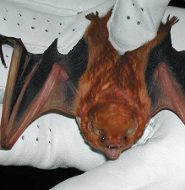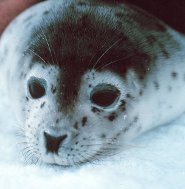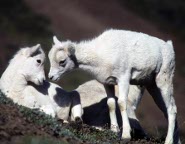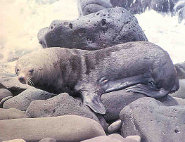Thursday 28 April 2011
The Red Bat

The
Red Bat (
Lasiurus borealis), is aptly named due to its distinctive reddish coloring. and is one of the mammals in which the males and females are differently colored. The male's fur is brighter shades of red to orange-red; while the females are duller red, chestnut, or brick. Both sexes have a frosted appearance from their white tipped hairs; however females are usually more frosted. Medium-sized, the Red Bat averages 4 to 5 centimeters (1.5 - 2 inches), with its total length about 9 to 12 centimeters (3.5 to 4.5 inches), including the tail. It weighs between 7 to 19 grams (1/4 to 5/8 ounces).
The Red Bat is unique in that instead of roosting in
caves, mining tunnels, or other interior spaces; it prefers to roost in the open in trees. Their range is from southern Canada, through the United States, and south to Chile and Argentina. They prefer forested areas, forest edges, or hedgerows. Their coloring helps them to blend in with the foliage, and hanging upside down, they look like dead leaves or pine cones. Although some Red Bats in the southern part of its range may stay in the same area year around, the northern ones migrate south in the winter, often in flocks, where they hibernate. A variety of locations are chosen for hibernation, often tree hollows, underneath shaggy bark, or even on the ground beneath fallen leaf litter.
The Red Bats are the first bats one usually sees flying around after sunset. Their favorite foods are moths and beetles, but they will settle for other insects, especially flying ones – the bigger the better. An unusual fact is that they follow the same routes each night for feeding. Predators include birds of prey and owls, snakes, mammals such as raccoons and
opossums, and large spiders such as tarantulas. However these prolific bats are not endangered.
The Red Bat usually lives alone, or as a mother with her young; except when migrating in flocks. Mating occurs in the fall, and in the spring the female gives birth, with litters of one to five babies. The pups are born blind, but learn to fly in about a month on average. They are weaned around 38 days old, and become independent. Thus begins the life cycle of the Red Bat.
You can help spreading the word about this animal by liking it on facebook
Permanent Link
Tuesday 26 April 2011
Spotted Seals - forming families on the ice

The
spotted seal (
Phoca largha) is a small bodied "true seal" with short flippers and a rounded head. As the name suggests, the adult coats, of both males and females, have dark spots on a light gray to silver base, though the seals are pure white as young pups. Both male and female spotted seals grow to roughly the same size as adults and are usually 1.5 meters (5 ft) long and weigh between 65 and 115 kilograms (140-200 lbs). These ice dwellers are known for forming seasonal family groups and for preferring open seas.
During the breeding season, spotted seals form monogamous pairs on the ice floes shortly before the females give birth. These pairings last for the entirety of the season, creating family groups of an adult male, adult female and a pup. Before the pair separates, they mate to conceive the pups which will be born next season. Gestation lasts for ten months, and pups are weaned at 4-6 weeks of age. The females reach maturity at 3-4 years of age, and the males are mature at 4-5 years of age. Spotted seals can live up to 35 years, so they will form many small families throughout their lifetimes.
Before the family groups separate and leave the ice floes, the pups are weaned, and they spend time learning to dive and catch prey. Juvenile Spotted Seals eat mostly krill and crustaceans, while adults feed primarily on larger fish, such as capelin, cod, herring and pollock. They are expert divers, reaching depths of over 300 meters (1500 ft) in pursuit of their prey.
Spotted seals are open water hunters, and even when the family groups are on more solid ice in the spring breeding season, they prefer shifting ice floes, rather than pack ice. In the summer they can be found in the open ocean in the sub-arctic or arctic waters of the North Pacific Ocean and adjacent seas. Spotted seals range from Alaska, through the western Sea of Japan and the Sea of Okhotsk, and through the Bering Sea.
The main threat to these family dwelling seals is climate change and diminishing ice floes, and they are classified as Low Risk-least concern on the International Union for Conservation of Nature's Red List. Populations of spotted seals in China and Russia, however, are considered threatened. Spotted seals are still hunted by people in some areas and by larger animals such as killer whales, walruses, sea lions and other predators throughout their range.
You can help spreading the word about this animal by liking it on facebook
Permanent Link
Thursday 21 April 2011
Dall's Sheep, the World's Only Wild White Sheep
 Dall's sheep
Dall's sheep (
Ovis dalli) is a wild sheep that is native to western Canada and the United States. These sheep, who can range in color from white to almost black and have curved horns, can be found high on the mountains in northwestern Canada and Alaska. Female ewes weigh a maximum of around 68 kilograms (150lbs) and the male rams can weight up to 113 kilograms (249lbs). Both ewes and rams stand up to be 90 centimeters (35 inches) at their shoulders. Body length also varies from 1.3 to 1.8 meters (51 inches to 70 inches) in males and 1.3 to 1.6 meters (51 inches to 63 inches) in females.
Both male and female Dall's sheep have curved horns, but the male's horns are much larger and thicker, and generally take about eight years until they are fully formed. Their horns are made of keratin, the same substance that your fingernails are made from.
Dall's sheep enjoy a diet of grasses, sedges, moss, lichens and willow. They will travel across vast terrain for the minerals provided by a salt lick. In the summer when food is abundant, a wide variety of plants and other vegetation are consumed. In the winter, they subsist of mostly dry, frozen grasses. These sheep have the ability to live in the harshest of environments, below the Arctic and in the Arctic Regions. They have hollow hair that gives them insulation, and they also favor south-facing inclines on the mountains, as it's easy to get much more sun that way.
These sheep love mountainous slopes because it's easy for them to get away from their predators on the rocks. Their predators are bears, wolves and golden eagles. Not to mention, people! These sheep are considered to be of the least concern with regards to conservation, meaning they are not endangered in any way.
A fun way to tell the age of a sheep is to look at its horns. The bigger they are, the older the sheep is, and they don't grow in the winter. Since they stop growing in the winter, the horns get growth rings. If you count these growth rings, you can tell the age of the sheep. The horns of the Dall sheep will be half a circle in about three years (seen from top), .75 of a circle in five and a full circle in about eight years. Simply count the growth rings on the horns and you'll know the age of the sheep.
You can help spreading the word about this animal by liking it on facebook
Permanent Link
Monday 11 April 2011
The Guadalupe Fur Seal - Back from Extinction

The
Guadalupe fur seal (
Arctocephalus townsendi) spends much of its time in the water, coming to land to breed. Named for their main breeding ground, Isla Guadalupe, the seals have been spotted on islands off the coast of Baja California, Mexico, as well as islands off the coast of southern California in the US. The elusive Guadalupe fur seal has not been studied much because of the rarity of sightings.
In the 19th century, Guadalupe fur seals were nearly driven into extinction along the Baja California coast by commercial sealers. Colonies off the southern California coast vanished by 1892, when the entire species consisted of only seven known seals. For a time, Guadalupe fur seals were believed to be extinct. Until 1954, only five seals had been spotted in addition to two Guadalupe fur seals that were housed in the San Diego Zoo. In 1954, a colony of 14 Guadalupe fur seals was spotted, and the species has been able to make a comeback. Despite the re-population of the species, the Guadalupe fur seal remains the rarest of the fur seals, and is still listed on the US endangered species list. In the 1970s, Isla Guadalupe was officially declared a refuge for the seals by the Mexican government, and the island population has grown to over 7,000.
Guadalupe fur seals grow to an adult size of 2.2m (7.2 feet) and 188kg (414.5 pounds) for males, and 1.5m (4.9 feet) and 49kg (108 pounds) for females, and have a lifespan of 17 - 20 years.The diet of the fur seal consists almost entirely of fish, which the seals swim out to sea to hunt. Guadalupe fur seals are sometimes hunted by
great white sharks, but historically the populations has been impacted most by the commercial sealing industry. Populations of the Guadalupe fur seals are limited to colonies, as the species does not migrate. Colonies occasionally relocate, but only if driven out of their current habitat.
Although the species does not migrate, the seals do have separate areas used for day-to-day living, and their May-July breeding season, when they prefer rocky, secluded areas. After giving birth, female Guadalupe fur seals venture out to sea for a 2-6 day feeding session.
You can help spreading the word about this animal by liking it on facebook
Permanent Link
 The Red Bat (Lasiurus borealis), is aptly named due to its distinctive reddish coloring. and is one of the mammals in which the males and females are differently colored. The male's fur is brighter shades of red to orange-red; while the females are duller red, chestnut, or brick. Both sexes have a frosted appearance from their white tipped hairs; however females are usually more frosted. Medium-sized, the Red Bat averages 4 to 5 centimeters (1.5 - 2 inches), with its total length about 9 to 12 centimeters (3.5 to 4.5 inches), including the tail. It weighs between 7 to 19 grams (1/4 to 5/8 ounces).
The Red Bat (Lasiurus borealis), is aptly named due to its distinctive reddish coloring. and is one of the mammals in which the males and females are differently colored. The male's fur is brighter shades of red to orange-red; while the females are duller red, chestnut, or brick. Both sexes have a frosted appearance from their white tipped hairs; however females are usually more frosted. Medium-sized, the Red Bat averages 4 to 5 centimeters (1.5 - 2 inches), with its total length about 9 to 12 centimeters (3.5 to 4.5 inches), including the tail. It weighs between 7 to 19 grams (1/4 to 5/8 ounces).
 The
The 
 The
The